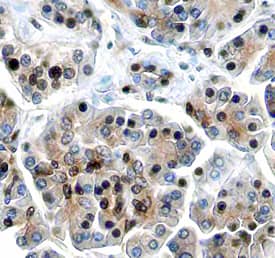Human GluR6/GRIK2 Antibody Summary
Thr32 - Asn549
Accession # Q13002
Customers also Viewed
Applications
Please Note: Optimal dilutions should be determined by each laboratory for each application. General Protocols are available in the Technical Information section on our website.
Scientific Data
 View Larger
View Larger
Detection of GluR6/GRIK2 in CHO Cell Line transfected with Human GluR6/GRIK2 by Flow Cytometry. CHO cell line transfected with human GluR6/GRIK2 was stained with Mouse Anti-Human GluR6/GRIK2 Monoclonal Antibody (Catalog # MAB9610, filled histogram) or Mouse IgG2A isotype control antibody (MAB003, open histogram), followed by Phycoerythrin-conjugated Anti-Mouse IgG Secondary Antibody (F0102B). Staining was performed using our Staining Membrane-associated Proteins protocol.
Preparation and Storage
- 12 months from date of receipt, -20 to -70 °C as supplied.
- 1 month, 2 to 8 °C under sterile conditions after reconstitution.
- 6 months, -20 to -70 °C under sterile conditions after reconstitution.
Background: GluR6/GRIK2
The Ionotropic Glutamate Receptors are a family of ligand-gated ion channels involved in regulating fast excitatory synaptic transmission in the central nervous system (CNS) (1, 2). The family consists of ~18 members which is divided into 3 groups based on the activating agonist: N-Methyl-D-Aspartate (NMDA), alpha -Amino-3-hydroxy-5-Methyl-4-isoxazole Propionic Acid (AMPA) and kainate (KA) (1, 2). KA receptors (KAR) are found in the pre- and postsynaptic membranes of the central nervous system, most prominently in the hippocampus, where they regulate synaptic transmission, neuronal excitability, and network activity (3). Glutamate receptor 6 (GluR6) (also Glutamate receptor ionotropic, kainate 2 or GluK2) along with GluR5, GluR7 and receptor subunits KA1 and KA2 belong to the KAR sub-group as these molecules are activated by kainic acid (1-3). Mature human GluR6 is a 3-transmembrane protein with a long (530 aa) N-terminal extracellular domain (ECD), a M2 domain involved in pore formation and a short C-terminal intracellular domain (4). The ECD of human GluR6 is highly conserved and shares 99% identity with both mouse and rat. Under physiological conditions, GluR6 forms either a homomeric or heteromeric receptor channel with GluR5 or KA1/2 to become functional (5, 6). Activation of KAR complexes result in Ca2+-dependent release of glutamatergic or GABAergic signals (7). The modulatory role of KARs make them attractive therapeutic candidates as glutamate excitotoxicity has been associated with multiple neurodegenerative and mental disorders. Misregulation of GluR6 has been suggested to be a factor in autism, Huntington disease and epilepsy (8). Additionally, GluR6 has been suggested to play a role in tumor suppression in Gastric cancer (9) while potentially displaying the opposite effect in urological cancers (10).
- Dingledine, R. et al. (1999) Pharmacol Rev. 51(1):7.
- Traynelis, S.F. et al. (2010) Pharmacol Rev. 62(3):405.
- Contractor, A. et al. (2011) Trends Neurosci. 34(3):154.
- Nanao, M.H. et al. (2005) PNAS 102(5):1708.
- Kumar, J. et al. (2011) Neuron. 71(2):319.
- Fisher, J.L. et al. (2011) J. Neurosci. 31(47):17113.
- Mathew, S.S. and Hablitz, J.J. (2008) Neuropharmacology. 55(1):106.
- Lerma, J. and Marques, J.M. (2013) Neuron. 80(2):292.
- Wu, C.S. et al. (2010) Int J Cancer. 126(11):2542.
- Inoue, R. et al. (2017) Oncotarget. 8(17):28826.
Product Datasheets
FAQs
No product specific FAQs exist for this product, however you may
View all Antibody FAQsReviews for Human GluR6/GRIK2 Antibody
There are currently no reviews for this product. Be the first to review Human GluR6/GRIK2 Antibody and earn rewards!
Have you used Human GluR6/GRIK2 Antibody?
Submit a review and receive an Amazon gift card.
$25/€18/£15/$25CAN/¥75 Yuan/¥2500 Yen for a review with an image
$10/€7/£6/$10 CAD/¥70 Yuan/¥1110 Yen for a review without an image








